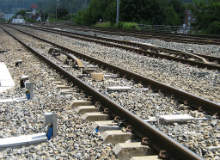
India operates the world’s third-largest railway network, with over 115,000km of track, 131,200 railway bridges and 7,112 stations. Every day 23 million passengers travel by train, and between 2014 and 2015, operator Indian Railways (IR) carried over eight billion passengers.
But upkeep of the network has lagged behind the increased demand, and chronic under-investment has led to poor track and station infrastructure and financial losses to IR. Tragically, the state of the railways has also led to loss of life for thousands of Indian people involved in the frequent train accidents.
Most recently, hordes of protestors disrupted traffic and set fire to trains on the Patna-Jhjaha mainline after an Indian youth was killed by a running train while he was crossing the tracks near Rajendra Nagar Terminal. Earlier in the same month, eight children were killed and several others injured as their school minibus was hit by a train at an unmanned railway crossing in Auraiye area, The Times of India reported.
Data from the National Crime Records Bureau shows that in 2014, a total of 27,581 Indians died in railway-related accidents, and a further 3,882 were injured. Most accidents were attributed to falling from trains, trains colliding with people on tracks, derailments, explosion and fire.
The vast majority of these deaths, 70%, took place at level crossings.
In response to the tragedies, the Indian Government has embarked on a mission to completely overhaul and modernise its railways before 2020, putting safety and security at the heart of their plan.
How well do you really know your competitors?
Access the most comprehensive Company Profiles on the market, powered by GlobalData. Save hours of research. Gain competitive edge.

Thank you!
Your download email will arrive shortly
Not ready to buy yet? Download a free sample
We are confident about the unique quality of our Company Profiles. However, we want you to make the most beneficial decision for your business, so we offer a free sample that you can download by submitting the below form
By GlobalDataAs part of its ’zero-accident mission’, IR has vouched to eliminate all unmanned level crossings on the broad gauge network over the next three to four years. The operator has also teamed up with long-term infrastructure partner Thales, which will see the French technology giant install its state-of-the-art train protection warning system (TPWS, elsewhere known as European train control system (ETCS)) on a 68km-long rail line near Chennai on a pilot basis.
This trial is the first step toward full implementation of the TPWS technology across 7,900 km of main lines across the country.
The technology trusted to deliver safer railways
TPWS helps prevent accidents caused by human error by automatically activating the train’s braking system if the driver misses a signal. TPWS also provides information on permissible speeds along the route.
This is made possible through a collection of electronic loops placed at 50m to 450m intervals along the tracks, which connect to a panel inside the train, detecting the speed and immediately stopping the train if it runs past a signal.
In a project due to be completed by the end of the year, 68km of track along the Basin bridge Arakkonam section of Southern Railway will receive the TPWS technology. The pilot is just one of the 28 TPWS projects to be deployed on Indian Railways over the next five years.
“With this, Thales brings to India the most advanced signalling system known as the ETCS that it has already successfully deployed in Europe,” said Thales VP and Country Director for India Antoine Caput. “It also demonstrates the interoperability of ETCS L1 track side equipment with existing ETCS L1 on-board systems.”
Thales also has been providing electronic axle counters to the Indian Railways since 1999 and has delivered a number of ticketing and telecommunications projects on the New Delhi, Mumbai, Bangalore, Jaipur, Gurgaon and Hyderabad metros.
“India is an important strategic market for Thales,” Caput said. “The company is perfectly in-line with the ’Make in India’ initiative, and ready to support the ongoing modernisation plan of the Indian Railways.”
India’s grand vision to 2020
Indian Railway’s planned revamp doesn’t stop at the new signalling technology.
“At present, we have a unique window of opportunity, which must be capitalised with a sense of urgency to transform railways to deliver timely benefits to the people and the nation,” Railway Minister Suresh Prabhu said in his budget speech.
As such, under the government’s Rs40,000 crore ($5.9bn) railway budget for 2016-2017, other flagship projects aim to digitalise ticketing services, improve performance and cleanliness and expand access to an even greater number of passengers.
As one of the main projects, a partnership with Google will bring WiFi to 100 train stations by the end of this year, with 400 more to follow next year.
Additionally, automatic ticketing machines, CCTV surveillance, digital displays for coaches, e-ticketing and digital booking solutions will be enhanced throughout the network and 1,600km of track will be electrified this year, followed by another 2,000km in 2017.
A programme of station redevelopment has also been initiated, which aims to monetise land and buildings through commercial exploitation of vacant land.
“Our core objective is to improve the quality of customer experience at the individual level, become an engine of employment generation and economic growth at the national level and convert India’s largest institution into a template for transformation,” Prabhu said.



